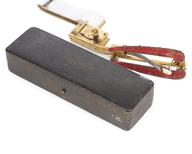

Hill and Barnard-type sphygmomanometer, London, England, 1891-1900
- maker:
- James Joseph Hicks

Hill and Barnard sphygmomanometer with case, by J.Hicks, English, c.1897, lead for Hill and Barnard
A sphygmomanometer is used to measure blood pressure. A rubber cuff was inflated above the elbow to block the pulse in the lower arm. When the pulse disappeared, the sphygmomanometer needle stopped vibrating to give a reading. This type of sphygmomanometer was invented in the 1890s by Sir Leonard Hill (1866-1952), a British physiologist, and Harold Barnard (1868-1908), a British surgeon. Measuring blood pressure as part of a health check did not become common practice until the 1920s. The device was made by James Joseph Hickman (1837-1916), a scientific instrument maker. It is shown here in a display depicting a consultation with a doctor in 1900.
Details
- Category:
- Clinical Diagnosis
- Collection:
- Sir Henry Wellcome's Museum Collection
- Object Number:
- A600280
- Materials:
- complete, leather, silk, brass (copper, zinc alloy), glass and rubber (unidentified)
- Measurements:
-
overall - case open: 112 mm x 230 mm x 368 mm, .658 kg
overall - tubing - lying flat: 147 mm x 325 mm x 380 mm, .106 kg
overall - case closed: 80 mm x 230 mm x 188 mm, .658 kg
overall - sphygmomanometer: 54 mm x 160 mm 120 mm, .772 kg
- type:
- sphygmomanometer
- credit:
- St. Marylebone and Western General Disp.




